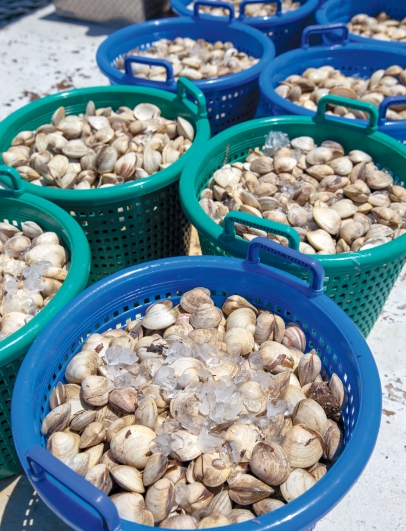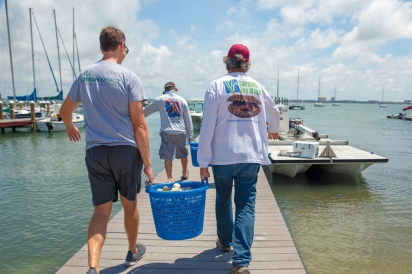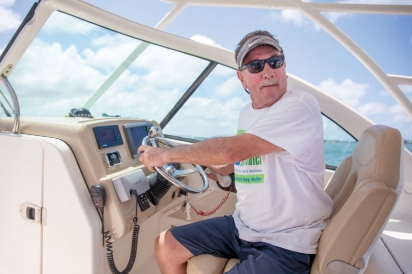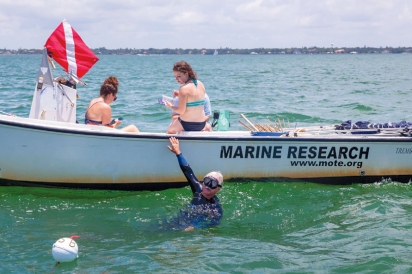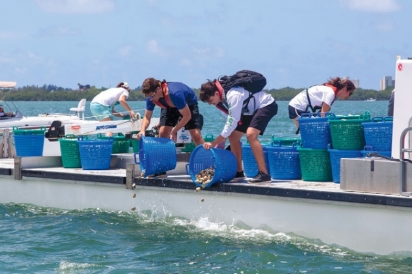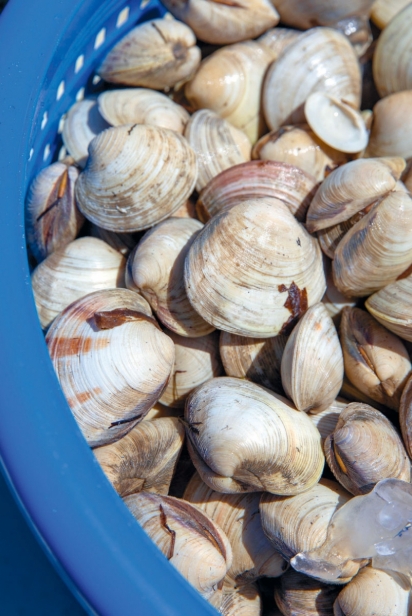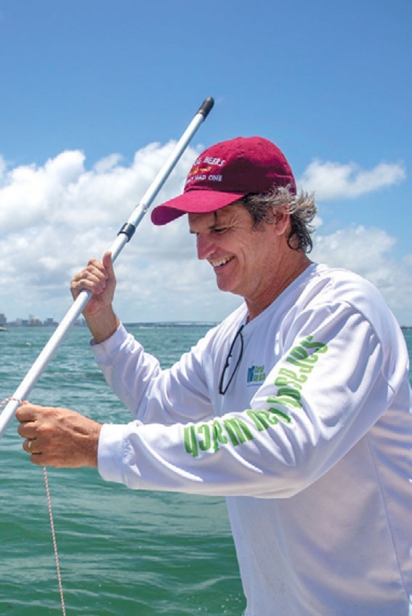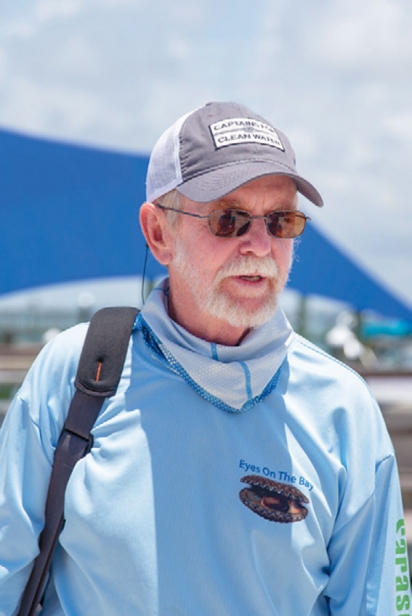Heroes In A Hard Shell: Clam restoration with Sarasota Bay Watch
Since the inception of the Sarasota Bay Watch more than 10 years ago, the scallop has served as the environmental organization’s lovable poster child. It’s easy to fall for scallops’ beady blue eyes, the way they propel themselves through water, and their ability to clean up to 90 gallons of seawater in one day of feeding. These celebrity shellfish have appeared as guests of honor at the Sarasota Bay Watch’s big annual fundraiser, Scallopalooza. They dine inside glass beakers, clarifying opaque, algae-thick water before the eyes of human attendees.
In their mission to improve our bay’s water quality and restore marine ecosystems, Sarasota Bay Watch has invested hundreds of volunteer hours and thousands of dollars in their scallop stars, introducing 100 million scallop larvae into local waters to date. However, scallops’ star power tends to fade fast. The scallop lifespan is brief (18 months at the outside) and too often shortened further by scallops’ susceptibility to predation and red tide.
Now it’s time for scallops to scoot over and share the limelight, because this summer there’s a new bivalve on the block.
Hardshell clams, commonly known as quahogs, are as tough as their name suggests. With a lifespan of up to 30 years, they’re less costly to raise, affording Sarasota Bay Watch the option to work with mature clams that aren’t so snackable by other marine life. As for red tide, these clams eat it for lunch. Compared to scallops, they aren’t as fast at filtration, they’re not so frilly, and they don’t swim like an adorable, tipsy Pac-Man. But the hardshell clam may prove to be a hero of Sarasota Bay.
It’s after 11 a.m. on what’s clearly shaping up to be the most gorgeous day in June. Rusty Chinnis, a founder of the Sarasota Bay Watch and its chairman emeritus, stands on the pier at the Sarasota Sailing Squadron and looks out on the bay. His eyes reflect sunlight sparkling off its surface, and more—a lifetime of love for the water and its denizens. In his career as a fisherman, photographer, and outdoor writer Chinnis has soaked up decades of memories featuring this environment. His biggest worry is that others after him won’t get the same chance.
“We want to be able to give back,” Chinnis says of the Sarasota Bay Watch. “The bay holds a lot of good things, and we’d like to see other people—the kids and future generations—have the same kind of opportunities to experience them.”
Meanwhile, a giant box truck rumbles up to the pier. Nurtured from spat expertly cultivated by Curt Hemmel of the Bay Shellfish Company, the truck’s contents were harvested early this morning at a clam farm down in Pine Island Sound. Pepper Dietz, a Sarasota native and treasurer of the Sarasota Bay Watch, jumps down from the cab. Despite two hours behind the wheel, Dietz’s contagious enthusiasm spreads to the half-dozen student volunteers who come hurrying to open the back hatch.
One ton of clams—roughly 30,000 of them, nestled in bushel baskets, shells and ice winking wetly in the sun—is an awesome sight. But the crew wastes no time marveling; they spring into action, teams of two hauling each heavy basket between them down the dock. Larry Beggs of Reef Innovations waits on his barge—a “freak of nature,” as Dietz calls the boat. Sarasota Bay Watch Co-President Stephen Martin lauds Beggs as a hero of this operation; without him, Sarasota Bay Watch would be forced to rally a small armada in order to shuttle the clams to their new home. Beggs’ barge normally transports locally made concrete reef balls for deployment in coral reef restoration projects. Loaded up with a ton of clams and seven warm bodies, the barge appears to defy several laws of physics as it cuts across the water like a hot knife through butter.
The chop intensifies at the drop site. While the barge pitches and yaws, the young crew looks completely unruffled as they drag bushels to the edge of the boat and heave clams overboard by the hundreds.
“It’s a real scientific process,” Chinnis jokes, but he’s not wrong; scientists from Mote Marine Laboratory stand by, ready to survey the results of today’s drop and set up experimental variables and controls for their research. Over the coming months, they’ll measure and monitor salinity, temperature, and sonic activity at Sarasota Bay Watch’s eight clam drops, then compare this data to the success of the clam population. They’ve also come armed with bundles of bamboo stakes to test out a deterrent to rays, one of the clams’ main predators.
This may sound a little ridiculous. But as they sail into the blue, before they splash down and sink 10 feet to the sand below, the hardshell clams look … happy.
So do Martin, Chinnis, and Dietz, observing the volunteers from Martin’s boat. Pride and hope are both palpable in the air. They know these clams are part of why humans have thrived in Florida for so long. Dietz, a 34-year vegetarian, is quick to note that’s not just because they’re tasty. They’re an essential contributor to the bay’s health; in turn, the bay’s health is essential to Sarasota’s vitality as a growing city.
“We need to get ahead of it before we’re behind the eight ball,” Dietz says, likening a dying bay to a nuclear disaster. “People will drive themselves far away from it.”
But the edible question stands: Thanks to Sarasota Bay Watch, might future generations find Sarasota Bay clams or scallops on fine restaurant menus?
“That would be wonderful,” Chinnis says. “But water quality is really the driving thing here, that and public awareness—to make people aware of what’s going on out there.”


